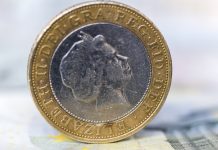After rallying to a high of US$1.2377 in early trade on Tuesday, the pound US dollar sipped back. The pair closed flat on the day at US$1.2357. The pound US dollar exchange rate is moving higher in early trade on Wednesday.
| What do these figures mean? |
| When measuring the value of a pair of currencies, one set equals 1 unit and the other shows the current equivalent. As the market moves, the amount will vary from minute to minute.
For example, it could be written: 1 GBP = 1.28934 USD Here, £1 is equivalent to approximately $1.29. This specifically measures the pound’s worth against the dollar. If the US dollar amount increases in this pairing, it’s positive for the pound. Or, if you were looking at it the other way around: 1 USD = 0.77786 GBP In this example, $1 is equivalent to approximately £0.78. This measures the US dollar’s worth versus the British pound. If the sterling number gets larger, it’s good news for the dollar. |
Stellar headline employment figures sent the pound soaring in early trade in the previous session. UK unemployment dropped to 3.8% a multi-decade low. Average weekly earnings also jumped 4% in the three months to July. This is the strongest growth that weekly earnings have experienced in 11 years. Strong wages create inflationary pressures; this is good news for the pound. Together these figures painted a rosy picture of the UK labour market even as Brexit approaches.
| How does strong jobs data boost the currency? |
| It works like this, when there is low unemployment and high job creation, the demand for workers increases. As demand for workers goes up, wages for those workers also go up. Which means the workers are now taking home more money to spend on cars, houses or in the shops. As a result, demand for goods and services also increase, pushing the prices of the goods and services higher. That’s also known as inflation. When inflation moves higher, central banks are more likely to raise interest rates, which then pushes the worth of the currency higher. |
However, delving deeper into the figures there was a cause for concern. Only 31,000 new jobs were created in the three months to July. This was well below the 115,000 reported the month previous. Whilst the UK labour market has proved to be resilient in the run up to Brexit, cracks could be starting to appear as hiring slows. The pound gave up its gains across the course of the previous session.
Today there is no high impacting UK economic data. Parliament is suspended for 5 weeks. Investors will be watching news flow surrounding Prime Minister Boris Johnson, his next moves and the bi-weekly Brexit talks.
Will US Factory Level Inflation Drag Dollar Lower?
The dollar moved marginally higher in the previous session. However, a lack of relevant data and trade headlines meant that any movement in the dollar was limited.
The dollar is caught between two moves. Firstly, dollar is the world’s reserve currency. Market participants and economists consider it to be a safe haven. This means that demand for the dollar can increase when geopolitical tensions rise, for example between US and China.
On the other side of the coin, there are growing fears that the US economy is starting to slow as the US — Sino trade dispute slowly spills over from the manufacturing sector to the broader economy. The weak non-farm payroll report last week is evidence of this. A weaker economy means the Fed is more likely to cut interest rates. This is keeping the dollar under pressure.
| Why do interest rate cuts drag on a currency’s value? |
| Interest rates are key to understanding exchange rate movements. Those who have large sums of money to invest want the highest return on their investments. Lower interest rate environments tend to offer lower yields. So, if the interest rate or at least the interest rate expectation of a country is relatively lower compared to another, then foreign investors look to pull their capital out and invest elsewhere. Large corporations and investors sell out of local currency to invest elsewhere. More local currency is available as the demand of that currency declines, dragging the value lower. |
Today there is no high impacting US data. However, inflation at factory level could catch investors attention. Analysts are predicting a 0.1% increase month on month. A weaker figure could pull the dollar southwards.
Currencylive.com is a site operated by TransferWise Inc. (“We”, “Us”), a Delaware Corporation.
The content on our site is provided for general information only. It is not intended to amount to advice on which you should rely. You must obtain professional or specialist advice before taking, or retain from, any action on the basis of the content on our site.
Although we make reasonable efforts to update the information on our site, we make no representations, warranties or guarantees, whether express or implied, that the content on our site is accurate, complete or up to date. Some of the content posted on this site has been commissioned by Us, but is the work of independent contractors. These contractors are not employees, workers, agents or partners of TransferWise and they do not hold themselves out as one. The information and content posted by these independent contractors have not been verified or approved by Us. The views expressed by these independent contractors on currencylive.com do not represent our views.





